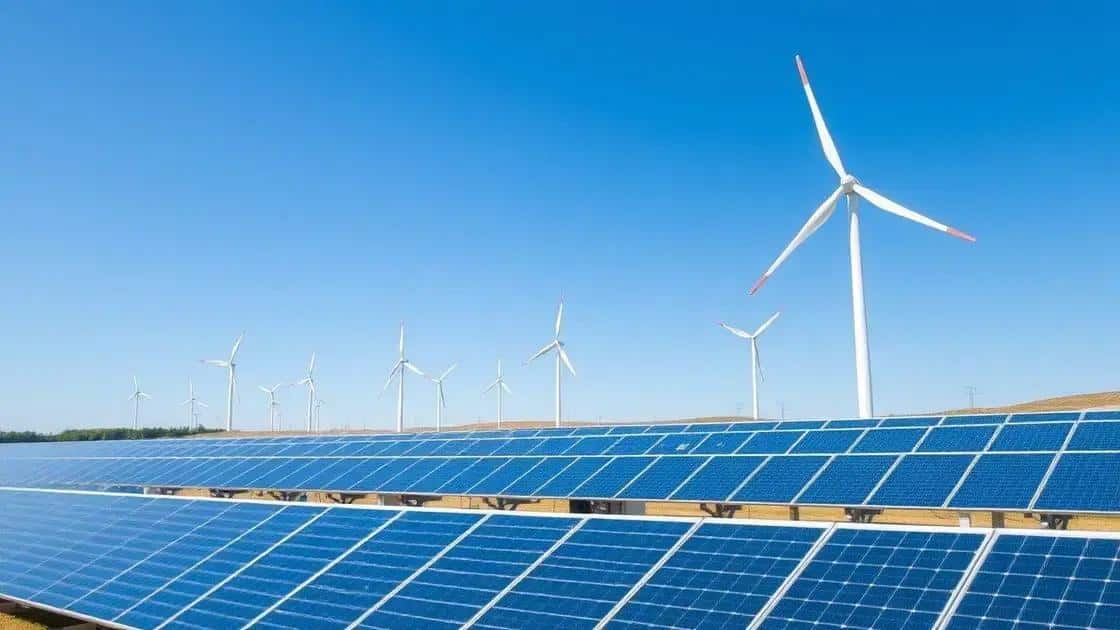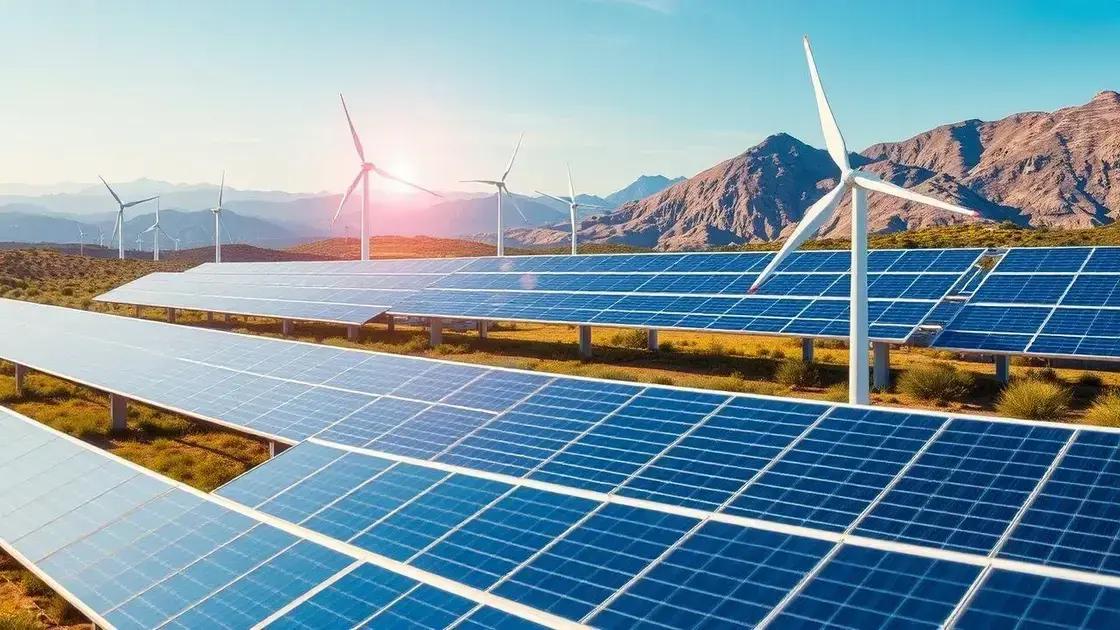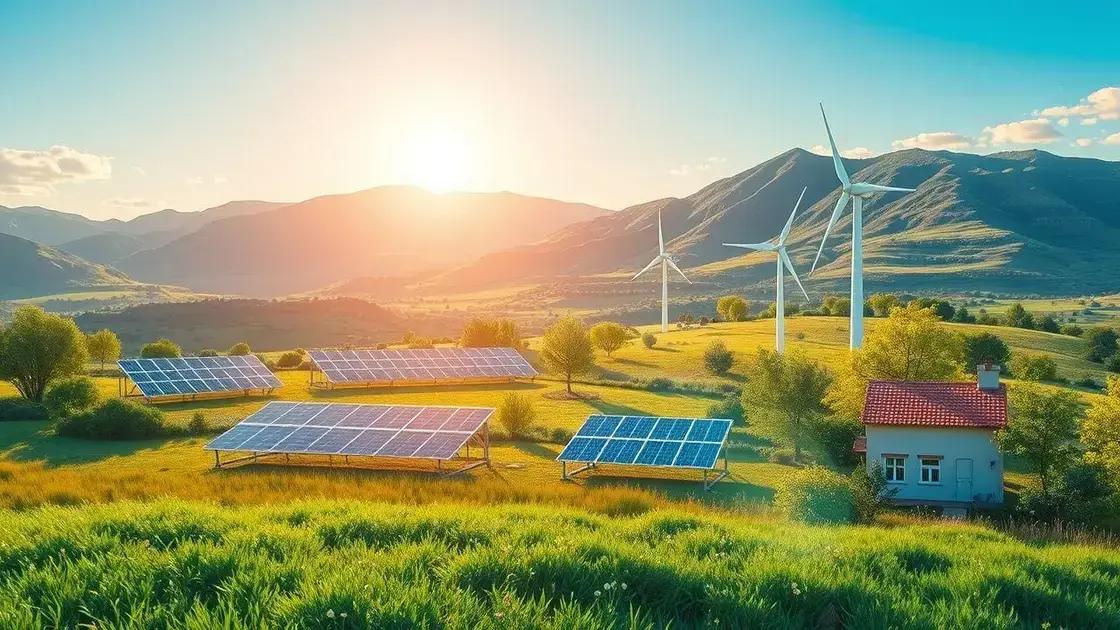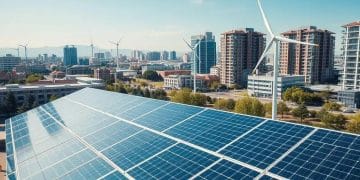Renewable energy expansion trends: a closer look

Renewable energy expansion trends highlight significant growth in solar and wind technologies, improved energy storage solutions, and increasing policy support, paving the way for a sustainable energy future.
Renewable energy expansion trends are reshaping our approach to energy consumption and sustainability. Have you considered how these trends impact your life and the future of our planet?
Current state of renewable energy expansion
The current state of renewable energy expansion is marked by significant growth and increased investment. Countries around the world are racing to enhance their renewable energy capacities, with solar and wind energy leading the way. As technologies improve, costs decrease, making renewable options more accessible to various sectors.
Global Renewable Energy Growth
In recent years, there has been a notable acceleration in the adoption of renewable energy solutions. Governments are establishing ambitious targets for reducing carbon emissions. This momentum is fueled by:
- Declining costs of solar panels and wind turbines.
- Increased energy demands from urban centers.
- Growing public awareness of climate change.
Notably, countries like Germany and China have made major strides in expanding their renewable energy sources. These nations serve as examples of how governmental policies can align with sustainable practices. In addition, many corporations are committing to 100% renewable energy targets, further pushing the growth of this sector.
Technological Advancements
Technological innovation plays a critical role in the renewable energy landscape. Advances in energy storage, particularly batteries, enhance the reliability of renewable sources. Energy grids are evolving to accommodate a more diverse energy mix, ensuring that renewable energy can be efficiently integrated. As a result:
- Energy storage systems are becoming more affordable.
- Smart grid technologies are improving energy distribution.
- Innovations in solar technology boost efficiency.
This ongoing transformation reflects a global shift toward cleaner, more sustainable energy solutions. As the industry evolves, it opens up new opportunities for investment, job creation, and environmental benefits.
Key technologies driving growth

Key technologies driving growth in the renewable energy sector are paving the way for a more sustainable future. Innovations are essential for enhancing energy efficiency and reducing costs. These technologies not only boost production capabilities but also expand access to clean energy sources.
Solar Energy Innovations
The solar energy sector has seen significant advancements. New materials, such as perovskite solar cells, are improving efficiency and reducing production costs. This makes solar energy more accessible for homeowners and businesses alike. In addition:
- Enhanced battery storage solutions allow for better energy management.
- Smart solar inverters improve performance and connectivity.
- Solar tracking technology increases energy generation throughout the day.
These innovations are vital, as they can help communities harness the sun’s power effectively.
Wind Energy Developments
Similarly, wind energy technologies are evolving rapidly. Larger and more efficient turbines are being built, allowing for greater energy capture. These advancements significantly contribute to global energy supply and environmental sustainability. Some key points include:
- Offshore wind farms are becoming more popular, harnessing powerful winds.
- Advanced turbine design increases overall energy output.
- Predictive maintenance technologies reduce downtime and expenses.
The integration of digital technology in monitoring and managing wind energy systems enhances reliability and efficiency. These developments illustrate how technology plays a crucial role in the transition to sustainable energy sources.
Challenges in the renewable energy sector
Challenges in the renewable energy sector are significant, impacting the pace of adoption and implementation. Despite the rapid growth of renewable energy sources, various barriers remain that need addressing to maximize their potential. Understanding these challenges can help guide future efforts.
Intermittency and Reliability
One major challenge is the intermittency of renewable sources like solar and wind. These energy sources produce power only when the sun shines or the wind blows, leading to reliability issues. To counteract these problems:
- Energy storage solutions, such as batteries, need improvement.
- Smart grid technology can help manage demand and supply.
- Backup systems are necessary to provide continuous energy.
By enhancing grid management and energy storage, we can mitigate the effects of this intermittency.
Infrastructure Limitations
Infrastructure challenges also hinder the growth of renewable energy. Many regions lack the necessary facilities and technology to support extensive renewable installations. This includes:
- Outdated power grids that cannot handle increased renewable inputs.
- Limited access to transmission lines, especially in rural areas.
- Insufficient investment in clean energy infrastructure.
Addressing these infrastructure issues is vital for future developments in the sector. More investments and upgrades are essential to support the broader distribution of renewable resources.
Regulatory and Policy Barriers
In many regions, regulatory and policy barriers also obstruct the development of renewable energy projects. Complex permitting processes and outdated policies can slow down development. To overcome these challenges,:
- Streamlined regulations can help facilitate project approvals.
- Incentives for renewable energy investments encourage growth.
- Effective policies can ensure a level playing field for renewables.
By fostering a supportive regulatory environment, we can accelerate the transition to renewable energy solutions.
Future outlook for renewable energy

The future outlook for renewable energy is promising, with exciting developments on the horizon. Increased awareness of climate change and the need for sustainable practices are driving this momentum. As technology advances, we can expect significant changes in how energy is produced and consumed.
Expansion of Renewable Technologies
Future trends indicate a substantial expansion in renewable technologies. Advancements in solar and wind energy are expected to lead the way. The global push for cleaner energy sources is likely to result in:
- Wider adoption of solar panels in residential areas.
- Investments in large-scale wind farms.
- Growth of energy storage technologies, enhancing reliability.
With these changes, renewable resources will play a critical role in meeting energy demands sustainably.
Policy and Investment Shifts
Policy frameworks and investments are also shifting to support the renewable energy transition. Countries around the world are increasingly committing to ambitious renewable energy targets. This shift will bring about:
- Increased funding for research and development in clean energy.
- Stronger international cooperation on climate initiatives.
- Enhanced incentives for businesses adopting renewable practices.
These changes reflect a growing recognition of the importance of a clean energy future.
Community and Consumer Influence
Communities and consumers will play a significant role in the energy transition as well. Growing environmental consciousness will drive demand for renewable options. Consumers will likely seek more ways to integrate renewable energy into their lives, leading to:
- A rise in community solar projects.
- Increased interest in electric vehicles powered by renewable energy.
- Support for businesses committed to sustainability.
This grassroots movement will push governments and companies to prioritize renewable energy solutions.
FAQ – Frequently Asked Questions about Renewable Energy
What are the main types of renewable energy sources?
The main types include solar, wind, hydroelectric, geothermal, and biomass energy.
How does renewable energy impact the environment?
Renewable energy significantly reduces greenhouse gas emissions and helps combat climate change by providing cleaner alternatives to fossil fuels.
What are the challenges facing renewable energy adoption?
Challenges include intermittency of energy supply, infrastructure limitations, regulatory barriers, and high initial investment costs.
What is the future outlook for renewable energy?
The future is promising, with advancements in technology, supportive policies, and increased public awareness driving further adoption and implementation.






